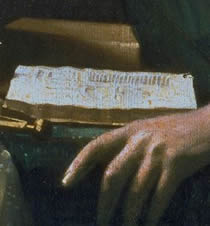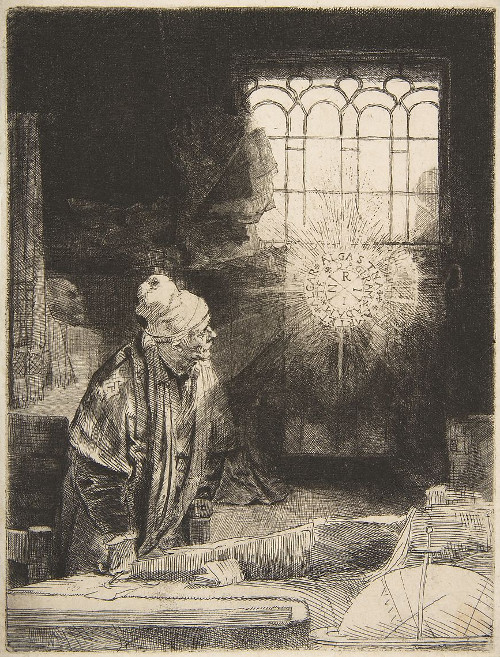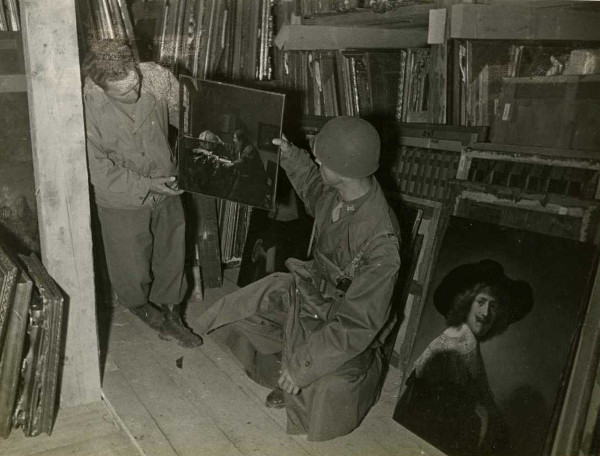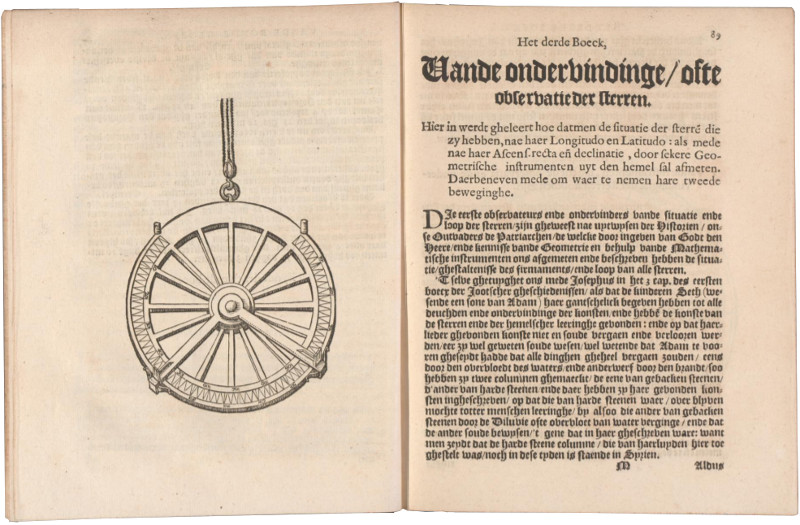The most intriguing link is that which lies latent in two paintings by Vermeer. In 1667 and 1668, a man in his late thirties posed for the painter as he worked on two seemingly associated pictures with scientific themes. These were Vermeer's only two paintings—at least the only two to survive—with solitary male figures as their protagonists; today the pictures are called The Astronomer and The Geographer, though the titles have varied in the past. In 1713 they were auctioned as "A work depicting a Mathematical Artist, by Vander Meer" and "A ditto by the same." When they came up for sale again a few years later they were described as "An Astrologer" and "A repeat" - i.e. another one of the same profession—and were referred to as "extra choice." Later still, the "Geographer" as he is now called was re-identified as "ct" or "a Surveyor." Obviously Vermeer intended the two men to be scholarly types. Although the astronomer has no telescope, he is shown touching a celestial globe, and the "Geographer" holds a pair of compasses or dividers and has a terrestrial globe nearby; both men have books to band. Indeed, a slightly idealized air permeates the pictures, which were probably commissioned work and thus balanced uneasily between the needs of client and painter. Some of the professional equipment may have been borrowed, including the cross-staff that hangs in deep shadow from the centre post of the window frame in The Geographer; such a staff could be used to measure heights (the height of the tower of the Nieuwe Kerk, for instance) or the angle of elevation of the sun. The date of 1669 now seen on The Geographer isn't original, though it is thought to reflect the date the picture was painted. That year, 1669, happens to be when Antonie van Leeuwenhoek qualified as a landmeter or surveyor.

Johannes Vermeer
c. 1668–1669
Oil on canvas
53 x 46.6 cm.
Städelsches Kunstinstitut, Frankfurt am Main, Germany
Johannes Vermeer
1668
Oil on canvas
50 x 45 cm.
Musée du Louvre, Paris
The model in both pictures appears to be the same man (fig. 1 &2.) He has a large, long, straight nose and full lips. Moreover, although there are differences in detail between the rooms the two scientists inhabit a section of stained-glass window in one and not in the other; the table carpets; a curtain moved from one side of the casement to the other—the actual room seems to be the same, with the same corner cupboard. The globes in the paintings, one celestial, one terrestrial, were a pair marketed by Jodocus Hondius in 1600. The book lying in front of the astronomer (fig. 3) has been identified as the 1621 second edition of a work by Adriaen Metius, On the Investigation or Observation of the Stars, and it is open at the beginning of Book III, where not only knowledge of geometry and the aid of mechanical instruments are recommended for this research but also "inspiration from God." The painting that hangs on the wall behind the astronomerhas for its subject the Finding of Moses (fig. 4 & 5), and perhaps acknowledges the same need for divine inspiration. Moses was described in the Acts of the Apostles as "learned in all the wisdom of Egypt"—a body of wisdom that would have included astronomy—and was also considered to be "the oldest geographer," because of his leadership of the Hebrews during their travels in exile. (As we have seen for some contemporaries, the United Provinces were the new Israel, the promised land.) Did Vermeer paint this Finding of Moses? It would be one more picture by Vermeer to add to the list of his missing works, and has been suggested as possibly 'the large painting by Vermeer' that the baker Hendrick van Buyten had—along with "two little pieces by Vermeer"—in his collection of pictures by mostly local painters.

Johannes Vermeer
1668
Oil on canvas, 50 x 45 cm.
Musée du Louvre, Paris

Johannes Vermeer
c. 1670–1671
Oil on canvas, 71.1 x 58.4 cm.
National Gallery of Ireland, Dublin

Johannes Vermeer
c. 1670–1671
Oil on canvas, 71.1 x 58.4 cm.
National Gallery of Ireland, Dublin
Both of the men in the paintings, whether astronomers, geographers, or surveyors, seem to be thinkers as much as practical scientists. Of the two, the geographer is less conspicuously deep in thought but simply caught in an abstracted moment. The pictures may have had a message which is now obscure, for nature then had meanings that would not be so evident to us, with signs of God's will to be seen nightly in the movement of the stars"—or, for that matter, in daylight, or for one Delft observer in the eel-like motion of protozoa. As Leeuwenhoek wrote, about some "'animacules" he observed in water from his gutter: "Once more we see here the unconceivable Providence, perfection, and ardor bestowed by the Lord Creator of the Universe upon such little creatures which escape our bare eye, in ardor that their kind shouldn't die auto' Inspiration from God, indeed. Both Vermeer's astronomer and his geographer are dressed in a similar way, in scholarly dressing gowns. This was traditional wear for this sort of portrait, as painted by Gerrit Dou, Leonaert Bramer, Rembrandt, and many Rembrandt followers including Nicolaes Maes. Rembrandt's etching of Faustus (fig. 6) has the scholar, in just such a loose robe, leaning aver his table while looking at a strange light that has appeared before his window. Whether I Vermeer knew of Rembrandt's etching can't be determined, but his geographer is seen in a similar pose, though without any alarming supernatural apparitions to catch his eye. Both of Vermeer's paintings demonstrate his usual sense of harmony and feeling for well-organized space, but we get a slight sense that, whatever his motive for undertaking these pictures, his heart wasn't completely in it. So, although it is possible that Vermeer himself served as his own model here, it seems more likely that the painter, perhaps, asked to paint allegories of scientific endeavor, portrayed someone he knew with scientific concerns.

Rembrandt van Rijn
c. 1652
Etching, drypoint, and burin; fifth of seven states, 21.7 x 16.7 cm.
Metropolitan Museum of Art, New York
Whether that person was Antonie van Leeuwenhoek is a question to which no conclusive answer can yet be given. If Vermeer had intended to represent the draper cum civil official turned scientist, he surely would have shown Leeuwenhoek with one of his microscopes; if Leeuwenhoek was merely the model, then possibly he was representing the Scientist (as the girl in The Art of Painting represented the Muse of History) and Vermeer didn't feel obliged to produce a close likeness. As mentioned, we know that Leeuwenhoek, having exercised himself for some time in "the art of Geometry," qualified as a surveyor in February 1669, the year that Vermeer seems to have painted his man holding dividers, and that he gained a reputation for his skills in navigation, astronomy, and mathematics. At thirty-seven, Leeuwenhoek would have been the right age for the scholar-scientist in Vermeer's pictures. Moreover, when Leeuwenhoek was portrayed explicitly nearly twenty years later by the Delft portraitist Jan Verkolje, he was shown in a pose that in many respects derived from Vermeer's Geographer, dividers in his right hand, a globe nearby, and wearing the same sort of robe and scarf. (It was acclaimed as an excellent likeness by none other than Constantijn Huygens, in some verses he wrote for the mezzotint Verkolje made from his painting.) In Verkolje's portrait, Leeuwenhoek has a nose very like that of Vermeer's model, but his face seems broad whereas that of the man in Vermeer's paintings looks long-though this discrepancy could be explained by the fact that Verkolje painted a fifty-four-year-old man and not one of thirty-seven.
Once again, we are left with questions as well as answers. It would obviously help if we knew who commissioned the two Vermeers or who first owned them; they first crop up in the art market in Rotterdam in 1713 at an auction where pictures belonging to Adriaen Paets, a Rotterdam city councilor and art patron, were being sold. The Dutch seaborne empire was then at its full extent, with cargoes of spices, silks, teak, coffee, and tea constantly arriving from distant colonies and trading posts to be landed in Rotterdam, Delfshaven, and Amsterdam. In any event, whoever modelled for the scientists in them, Vermeer's paintings demonstrate a willingness to be interested in the greater world, both terrestrial and celestial, and an awareness of the knowledge of both spheres needed for navigation—a world beyond Delft.
The Celestial Globe and the Book on the Table
Both works are also dated: The Astronomer 1668 and The Geographer the following year. The date on The Astronomer is inscribed in Roman numerals on the cupboard (fig. 7), just above the scholar's hand. It is possible that the year was added by a later artist, since it does not appear in the reversed image of an engraving by Louis Garreau of 1784, but if this is the case the date is likely to have been copied from a reliable source, such as an inscription on a lost frame.

The astronomer sits at a table, bending forward to turn the celestial globe. Above the cupboard are at least ten books of various sizes, and attached to the front is a curious diagram with a large circle and two smaller circles in the upper corners, all with 'hands', but its significance is obscure. On the wall is a painting of 'The Finding of Moses', which reappears in Lady Writing a Letter with Her Maid (fig. 4 & 5).
The celestial globe, which sits on a four-legged grand, was first published by Jodocus Hondius in Amsterdam in 1600.
In Vermeer's painting the constellations on the upper half of the globe which face the viewer include the Great Bear on the left, the Dragon and Hercules in the centre, and Lyra on the right.

Rennerus Arsenius 1569
41 x 30 x 3,5 cm; weight: 3 kg.
Conservatoire National des Arts et Mmétiers, Paris
On the table lies an open book. The presence of an illustration on the left-hand page has made it possible to identify the text as the second edition of Adriaen Metius's On the lnvestigation or Observation of the Stars, published in Amsterdam in 1621. Vermeer has reproduced the first two pages of section 111. The text on the right-hand page explains how "one can learn to measure in the sky through certain geometrical instruments the situation the stars have in accordance with their longitude and latitude." Below the globe lies a brass astrolabe (fig. 8), an instrument used in navigation and for measuring the position of celestial bodies, similar to that shown in the illustration on the left-hand page of the open book.
Vermeer's painting was acquired in the 1880s by the Paris-based banker Baron Alphonse de Rothschild. In 1940 the Nazis confiscated it from his son Édouard and Hitler ordered it to be taken to Germany. In 1945 The Astronomer was returned (fig. 9) to the Rothschild family and acquired by the Musée du Louvre in 1983.

James Welul
"Vermeer's Astronomer: Observations on an Open Book"The Art Bulletin, vol. 68, no. 2, pp. 263-267
 Fig. 1o A Portrairt of Adriaen Metius
Fig. 1o A Portrairt of Adriaen Metiusunknown painter
17th century
Museum Martena, Franeker, the Netherlands
Jan Vermeer's Astronomer, signed and dated 1668, has long been associated with his Geographer, a work of about the same size and painted about the same time. These two pictures were sold together as companion pieces four times during the eighteenth century, beginning in 1713 when they were first recorded. Both show a man engrossed in scientific investigation using objects that relate, in the one, to the celestial realm, in the other, to the terrestrial. The titles by which these two paintings have come to be known are, therefore, most appropriate.
In The Astronomer a man directs his attention toward a large celestial globe on the table in front of him. Also on the table are an astrolabe, a pair of dividers, and several books. The astronomer has opened one of the volumes, which serves as his guide. This book provides insight not only into the subject of Vermeer's painting, but into its complex relationship with The Geographer.
As with many of the objects in Vermeer's paintings, the book in The Astronomer can be identified. It is Adriaen Metius' (fig. 10) basic volume on astronomy and geography, opened to the first two pages of book III (fig. 11), "On the Investigation or Observation of the Stars." The right page is filled with text, while the left illustrates the so-called cartwheel astrolabe, which Metius himself invented. A photograph of the book as seen from approximately the same angle as in Vermeer's Astronomer verifies the painter's source.

Adriaen Metius,
1621
Leiden University Library, Leiden
Vermeer's detailed rendering enables us to identify not only the book but also the specific edition. Metius' work appeared in 1614 and 1621, and the page of text rendered in Vermeer's painting has several differences between the first and second edition. The differences are sufficient to verify that the artist used the second edition. Intended for both the professional and the amateur, Metius' book is a practical guide for using instruments connected with the study of both astronomy and geography. In practice these two branches of cosmography were more closely related during the seventeenth century than they are today. A person active in one was usually active in the other. For example, Holland's greatest mapmaker, Willem Jansz. Blaeu, was involved in charting not only the earth but also the heavens, and in doing so made numerous important astronomical observations. Like Metius, Blaeu had studied under the great Danish astronomer, Tycho Brahe. Seventeenth-century cartographers were very dependent upon a knowledge of astronomy, since it was mainly through a study of the celestial bodies that they were able to determine latitude, particularly at sea. It is no surprise, therefore, to find that Metius' book was also intended for "shippers and pilots" and includes "short and clear instructions for the art of navigation."
The Map of the Netherlande

Christiane Hertel
"Seven Vermeers"The Cambridge Companion to Vermeer (Cambridge Companions to the History of Art)
2001, p. 152
The silk robe is also worn by Antonie van Leeuwenhoek (1632–1723), the cloth merchant, inventor, and builder of microscopes, discoverer of spermatozoa, and executor of Vermeer's estate (or, rather, posthumous bankruptcy), in an undated portrait by Jan Verkolje (1653). But while Verkolje's Van Leeuwenhoek also holds dividers and has Hondius's globe next to him on the table, he looks directly and firmly out at the beholder and wants to be acknowledged as an identified sitter. His accouterments, including the silk robe, are subordinated to his portrayal. Vermeer's geographer looks we don't quite know where, and Vermeer's beholder is foremost faced with cropped barriers, the pushed-up rug on the table and a low wooden stool on the right with a square on it. As the geographer doesn't hold our gaze with his own, his accouterments take on importance in characterizing him for us.

The Rijksmuseum, Amsterdam
Both the silk robe and rug are clear referents to the Orient, that is, to Japan and to the Levant. The so-called Japonsche rok (fig. 12) was a highly desired garment, a kimono tailored into a kind of house robe. In Vermeer's and Van Leeuwenhoek's (fig. 13) days such keizersrokken, or Imperial kimonos, were gifts given in batches of thirty and sometimes even more to Dutch merchants who passed the test of their annual visit to the Imperial court in Edo (Tokyo). This visit was their only permitted sojourn on the Japanese mainland; at all other times they were confined to Deshima, the island assigned to them for the duration of their star in Japan. Thus these robes were neither merchandise in Japan nor clearly for sale back home in Holland. There they were worn indoors by scholars, amateurs, gentlemen, even mayors. By the mid-eighteenth century they were made from imported Indian and Chinese silk and became a more common imitation ware. In Vermeer's day, then, for his geographer to wear a Japon is to wear an as yet not commodified garment, in a way quite in keeping with Friedländer's idea of Vermeer.
The motif of the pushed-back rug reappears in The Astronomer and, somewhat mysteriously, as if pushed back from "our" end of the table, in A Woman Asleep at a Table, and as a suggestively precarious support for the Chinese bowl of fruit in Girl Reading a Letter at an Open Window. The motif's connotation of leisure is evident in Ter Borch's depictions of ladies receiving or writing "love letters." In Ter Borch's A Lady Writing a Letter (The Hague, Mauritshuis) and Lady Reading a Letter (London, Wallace Collection), the women prefer the table's plain wooden surface to the rug. The bed in the one and the folding screen in the other painting characterize these interiors as women's private spaces. By contrast, Metsu depicts a Man Writing a Letter (Dublin, National Gallery of Ireland) who seems to be acting on impulse when he writes on a sheet of paper bulging over a table rug's folds and does not take the time to push the rug back.

Jan Verkolje (I)
Oil on canvas, 56 x 47.5 cm.
Rijksmuseum, Amsterdam

Jan Steen
Oil on canvas, 79 x 104 cm.
Museum Boijmans van Beuningen, Rotterdam, Netherlands
In Easy Come Easy Go (fig. 14) (1661; Rotterdam, Museum Boijmans Van Beuningen), Steen represents a happy squanderer who is seated at a table with a partly pushed-back, partly napkin-covered rug on it that contributes a sense of disorder. Finally, in Metsu's The Duet (London, The National Gallery), we see a rug pushed back so as to make room on the table far the violin and to reveal the wine jug underneath. By contrast, in Vermeer's Music Lesson and Young Woman with a Water Jug, we see orderly, straightened rugs. With its connotations, at least in the examples cited of love letters, squandering, drinking, and courting, the motif of the pushed-back rug adds an element to the geographer's situation that seems not quite in keeping with his presumably serious, rational, scientific occupation.
Thoré, as we saw, makes sense of all that is here by linking the landscape of the sumptuous Turkish rug and the Japanese silk robe with the man's moment of suspense or reflection by filling the latter with the former, thus attributing to him a longing for the East Indian "atmosphere and color."

